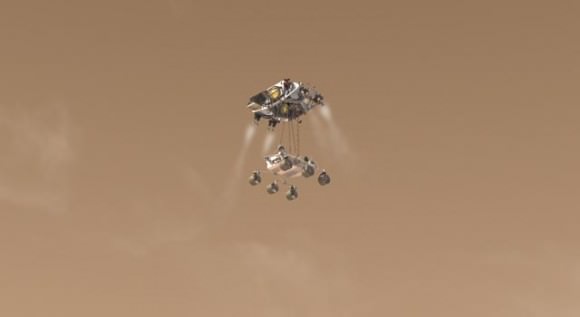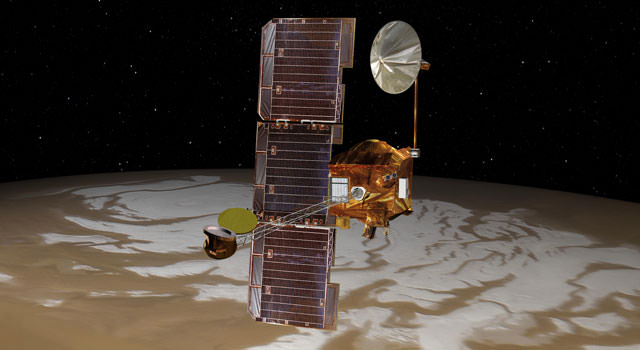Caption: NASA’s Mars Odyssey spacecraft passes above Mars’ south pole in this artist’s illustration. The spacecraft has been orbiting Mars since October 24, 2001. Image credit: NASA/JPL
The “seven minutes of terror” could stretch into a longer time of trepidation for the hopeful Mars rover team and fans waiting back on Earth to find out if the Curiosity rover has landed safely. A problem with the Mars Odyssey orbiter means there could be a delay in the telemetry relayed to Earth as the Mars Science Laboratory descends and lands on Mars on August 5/6, 2012.
“There’s no impact to landing itself,” said NASA’s Mars exploration program chief Doug McCuistion at a press briefing on Monday. “It’s simply how that data gets returned to us and how timely that data is.”
McCuistion said the Odyssey team is assessing why the orbiter has gone into safe mode several times since early June, as well as having problems with its attitude control system. The glitches possibly could mean the spacecraft may not be in position to track and relay real-time data from MSL as it descends through Mars’ atmosphere and lands, possibly delaying the telemetry to Earth by several hours.
Curiosity’s automated landing sequence won’t be affected; it’s just that the data won’t be sent immediately – and the 14-minute communications lag between Earth and Mars means that the MSL team won’t be getting real-time updates about the rover’s perilous journey anyway; however, now it might be an even longer delay.

Caption: This artist’s concept from an animation depicts Curiosity, the rover to be launched in 2011 by NASA’s Mars Science Laboratory, as it is being lowered by the mission’s rocket-powered descent stage during a critical moment of the “sky crane” landing in 2012. Image Credit: NASA/JPL-Caltech
The rover is scheduled to land at 10:31 p.m. PDT on Aug. 5 (05:31 UTC, 1:31 a.m. EDT on Aug. 6).
Under normal circumstances, it’s a challenge for the orbiters to get in position to welcome another spacecraft to Mars, and provide tracking data and telemetry relay.
“If we were not to do anything, the Mars’ orbiting spacecraft may be on the other side of the planet,” said MSL navigation team chief Tomas Martin-Mur, during a previous interview with UT. “So as soon as we launch, we tell the other spacecraft where we are going to be by the time of entry so they can change their orbits over time, so they will be flying overhead as MSL approaches the planet.”
The orbiters – which also includes NASA’s Mars Reconnaissance Orbiter and ESA’s Mars Express – have been doing special maneuvers to be aligned in just the right place, nearby to MSL’s point of entry into Mars’ atmosphere.
But the glitches for Odyssey means it may not be in the right place.
MRO will be attempting to image the rover as it descends and lands — with possible hopes of catching the rover as it is descending on the “sky-crane” landing system — but MRO can only record data for later playback, whereas Odyssey could provide immediate relay. Mars Express won’t be aligned to see the last minute of flight, McCuistion said.
The Odyssey orbiter put itself in the precautionary, Earth-pointed status called safe mode on July 11, as it finished a maneuver adjusting, or trimming, its orbit. Odyssey’s computer did not reboot, so diagnostic information was subsequently available from the spacecraft’s onboard memory. Based on analysis of that information, the mission’s controllers sent commands yesterday morning taking Odyssey out of safe mode and reorienting it to point downward at Mars.
“We are on a cautious path to resume Odyssey’s science and relay operations soon,” said Gaylon McSmith, Odyssey project manager. “We will also be assessing whether another orbit trim maneuver is warranted.”
The landing is one of the most perilous times for a rover. “Those seven minutes are the most challenging part of this entire mission,” said Pete Theisinger, MSL’s project manager. “For the landing to succeed, hundreds of events will need to go right, many with split-second timing and all controlled autonomously by the spacecraft. We’ve done all we can think of to succeed. We expect to get Curiosity safely onto the ground, but there is no guarantee. The risks are real.”
We’ll provide updates as to Odyssey’s status. Here’s a look at the seven minutes of terror MSL will experience:


Probably because of the bloody “Host Process for Windows Services”!
Solar flare again? I wonder, since there have been so many shut-downs on the Odyssey, is there any pattern worth noting? How would one correlate the Position of the orbiter against each of the shutdowns.?
The WSA-Enlil solar wind model is pretty good at showing where and when CME’s will track past Earth. http://www.swpc.noaa.gov/wsa-enlil/
SpaceWeather.com occasionally posts whole solar system views, which I really like… this one only extends out to cover Earth..